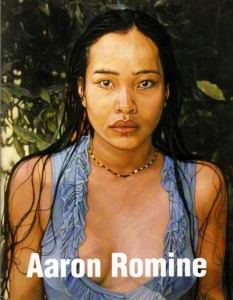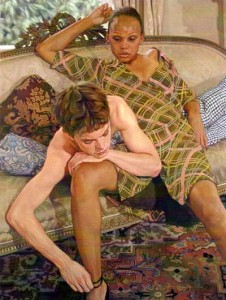For Kravets/Wehby Gallery

Two things in Aaron Romine’s paintings jump out at you right away. First, there is the obvious and unusual skill with which they are painted. Then, there is the sex. Perhaps most eyebrow raising is the over 6 foot long ‘Untitled (Esso, Taise and Kerry)’ in which three larger than life women begin a charged romantic encounter.
Two characters from this group appear in another untitled canvas, a party scene in which a topless Esso straddles a coffee table while Taise eyes her with a look that can only be described as wicked. To either side, fully clothed partygoers embrace, talk or stare into space. In both scenes it’s the people, not their surroundings, which draw our attention. Some, like Esso, appear in more than one painting, which makes it tempting to image who they are and how they are involved with the people around them. This is particularly true in paintings of the impassive Natasha, for example, who poses variously with Charlie or Peter in intimate or post-sex scenarios. The impulse is to read the scenes as documentary and suppose that Romine has access to a world of beautiful people living for sensual excess. 
In conversation, Romine will freely mention the names of painters he admires from previous centuries, an inclination that tends to invite comparison between his work and theirs. Any search for direct sampling will be disappointed, however, because while Romine has taught himself to paint by looking at old masters, his style is completely contemporary. Flip through any art history survey book and it’s a guarantee that you won’t be able to match styles and poses with Romine’s paintings. What will happen is that Romine’s composition and his foregrounding of physical, emotional and erotic relationships find the right context. All of a sudden, the lesbian trio’s careful arrangement of limbs slots into a tradition as old as daVinci’s scrambling disciples at the last supper and as sensual as Ingres’ Turkish baths. Olivia’s sprawled position on the couch in ‘Je le vaux bien (Olivia and Nicholas)’ relates to odalisques from Titian to Manet. Centuries of history obscure an old master’s original intentions, the identity of his sitters and other details, so that what’s left to do when viewing his paintings is to consider their style or look for clues that explain the given scenarios. Likewise, Romine creates a certain distance between viewers and his subjects by carefully staging his scenes before photographing and then painting them. As we stop, look and ponder, the dynamics between sitters speak for themselves. Time slows down as we become absorbed in the way Charlie plucks at Natasha’s shoe strap, for example, or the way the sunlight delicately illuminates their shoulders. Romine converts models in contemporary dress into timeless characters, stopping us in our tracks as we rediscover the pleasure of looking.
